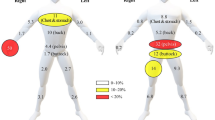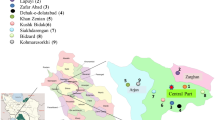Abstract
The potential dermal and respiratory exposure assessment and risk assessment for applicator were performed with cypermethrin EC. The pesticide was applied on a mandarin field using a power sprayer. Gloves were used for the hand exposure assessment, mask for face, and dermal patches for the other parts of the body. Personal air monitor equipped with a XAD-2 resin was used for the respiratory exposure assessment. During the application of cypermethrin in the field, the rate of potential dermal exposure ranged from 28.1 to 58.8 mg/h. The major exposure parts were upper-arms (22.1–24.6%) and legs (thigh and shin, 28.3–29.2%) for females and thigh (21.0–46.9%) and hand (14.9–19.3%) for males. Females were exposed more than males. No exposure was detected from the respiratory monitoring. For risk assessment, the potential dermal exposure (PDE), the absorbable quantity of exposure (AQE), and the margin of safety (MOS) were calculated. Among those four risk assessments, MOS was <1 in only trial I, which indicated any possibility of risk. However, in the others, the possibility of risk was little. Moreover, the safe work time ranged from 3.61 h to 9.69 h.
Similar content being viewed by others
References
Calumpang SMF, (1996) Exposure of four filipino farmers to parathion-methyl while spraying string beans. Pestic Sci 46:93–102
Durham WF, Wolfe HR (1962) Measurement of the exposure of workers to pesticides. Bulletin of World Health Organization 26:75–91
Feldman RJ, Maibach HI (1974) Percutaneous penetration of some pesticides and herbicides in man. Toxicol Appl Pharmacol 28:126–132
Fenske RA, Elkner KP (1990) Multi-route exposure assessment and biological monitoring of urban pesticide applicators during structural control treatments with chlorpyrifos. Toxicol Ind Health 6:349–371
Flannigan SA, Tucker SB (1985) Validation in cutaneous sensation between synthetic pyrethroid insecticides. Contact Dermatitis 13:140–147
Garrod ANI, Rimmer DA, Robertshaw L, Jones T (1998) Occupational exposure through spraying remedial pesticides. Ann Occ Hyg 42:159–165
Jensen JK (1984) The assumptions used for exposure assessments. In: Siewierski M (ed) Determination and assessment of pesticide exposure. Elsevier, New York, p 147–152
Kieczka H, (1993) Requirements for safe-guarding the health of applicators of plant protection products: an overview. In: Second International Symposium on Pesticides Application Techniques, Strasbourg, Annals, n. 2/2. BCPC, Strasbourg, p 455–462.
Krieger RI, Bernard CE, Dinoff TM, Fell L, Osimitz TG, Ross JH, Thongsinthusak T (2000) Biomonitoring and whole body cotton dosimetry to estimate potential human dermal exposure to semivolatile chemicals. J Expos Anal Environ Epidemiol 10:50–57
Liu KH, Byoun JY, Sung HJ, Lee HK, Kim K, Lee HS, Kim JH (2001) Simultaneous determination of furathiocarb and metabolites in biological tissues by high-performance liquid chromatography and post-column derivatization. Chromatographia 53:687–690
Lessenger JE, (1992) Five office workers inadvertently exposed to cypermethrin. J Toxicol Environ Health 35:261–267
Machado-Neto J. G.., (2001) Determination of safe work time and exposure control need for pesticide applicators. Bull. Environ Contam Toxicol 67:20–26
Machera K, Kapetanakis E, Charistou A, Goumenaki E, Glass RC (2002) Evaluation of potential dermal exposure of pesticide spray operators in greenhouses by use of visible tracers. J Environ Sci Health B 37:113–121
Popendorf W, Selim M, Lewis MQ (1995) Exposures while applying antimicrobial pesticides. Am Ind Hyg Assoc J 56:993–1001
Predictive Operator Exposure Model (POEM) (1992) A user guide. Pesticide Safety Directorate, UK
Renwick AG (2000) The use of safety or uncertainty factors in the setting of acute reference doses. Food Addit Contam 17: 627–635
Rutz R, Krieger RI (1992) Exposure to pesticide mixer/loaders and applicators in California. Rev Environ Contam Toxicol 129:121–139
Severn DJ (1984) Use of exposure data for risk assessment. In: Siewierski M (ed) Determination and assessment of pesticide exposure. Elsevier, New York, p 13–19
Stamper JH, Nigg HN, Mahon WD, Nielsen AP (1988) Pesticide exposure to greenhouse foggers. Chemosphere 17:1007–1023
Tomlin C (2000) The pesticide manual, 12th ed. British Crop Protection Council, Farnham
Van Hemmen JJ, (1992) Agricultural pesticide exposure database for risk assessment. Rev Environ Contam Toxicol 126:2–85
Vidal JLM, Gonzalez FJE, Frenich AG, Galera MM, Aguilera PA, Carrique EL (2002) Assessment of relevant factors and relationships concerning human dermal exposure to pesticides in greenhouse applications. Pest Manag Sci 58:784–790
Acknowledgments
This work was supported in part by the Rural Development Administration and Brain Korea 21 project.
Author information
Authors and Affiliations
Corresponding author
Rights and permissions
About this article
Cite this article
Choi, H., Moon, J., Liu, K. et al. Risk Assessment of Human Exposure to Cypermethrin During Treatment of Mandarin Fields. Arch Environ Contam Toxicol 50, 437–442 (2006). https://doi.org/10.1007/s00244-005-1050-3
Received:
Accepted:
Published:
Issue Date:
DOI: https://doi.org/10.1007/s00244-005-1050-3




